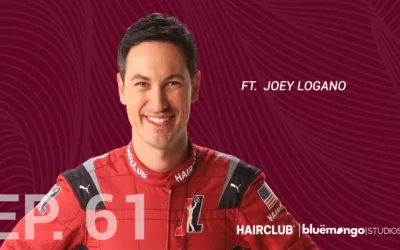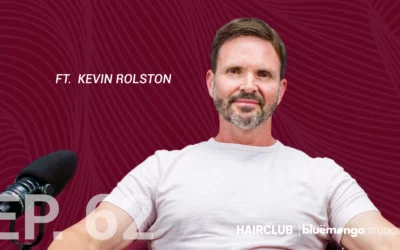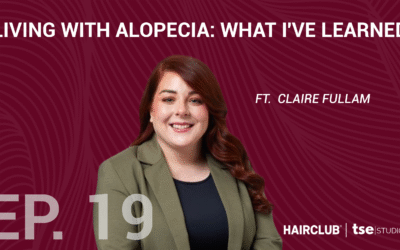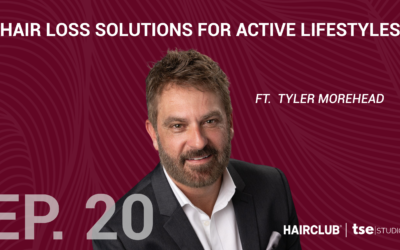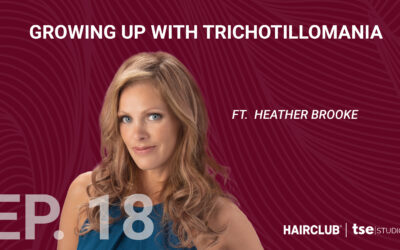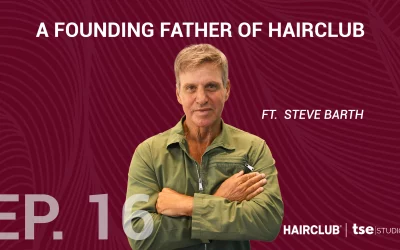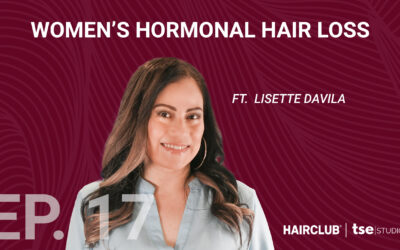Joey Logano on NASCAR wins, playoff pressure, and how HairClub helps him stay confident on and off the track.

Women’s Hormonal Hair Loss & What to Do
Episode 17
Understanding Hormonal Hair Loss in Women

Understanding Hormonal Hair Loss in Women: Causes and How To Treat It
Although it’s most commonly associated with men, hair loss can also impact women.
In fact, women may be more vulnerable to hair loss as they age, thanks to fluctuating hormones associated with pregnancy, menopause, and other hormonal shifts. At least 50% of women will experience hair loss at some point in their lifetime.
On this episode of HairPod, we explore Lisette Davila’s story with hair loss treatments and hormone replacement therapy. Learn more about hormonal hair loss in women through the lens of Lisette’s experiences — her challenges, the stigma she encountered, and the hope she found through her courageous pursuit of answers.
Types of Hormonal Hair Loss
Hormonal hair loss in women can happen for many reasons, but in Lisette’s case, the cause was a hormonal imbalance. Here are the three most common types of hair loss for women.
Female Pattern Baldness
The most common type of hormonal hair loss in women is female pattern hair loss (FPHL), also known as androgenetic alopecia or female pattern baldness. It affects about 30 million women in the U.S.
Over time, hair becomes finer and shorter and the volume gradually decreases. Unlike the distinctive receding hairline seen in male pattern baldness, female pattern baldness typically looks like thinning across the scalp, particularly at the crown and part line.
Telogen Effluvium
Telogen effluvium is a common type of hair loss that happens after experiencing severe stress. Hair loss and thinning tend to happen within two to three months after the stressor, but in most cases, it resolves itself after six months.
Traction Alopecia
Traction alopecia occurs when hair is subjected to constant tension and pulling. While it’s not linked to hormones, it’s most common in women who frequently wear tight hairstyles like ponytails, braids, or buns.
Over time, repeated tension on the hair follicles can lead to thinning hair or permanent hair loss, especially around the hairline or temples. If it’s caught early, traction alopecia can be reversed. But if the tension isn’t resolved, it can cause irreversible damage to the follicles.
Symptoms of Hormonal Hair Loss
It took years for Lisette to pinpoint the source of her noticeable hair loss: hormones. But looking back, there were many symptoms to suggest that hormones were a culprit.
Here are some of the hair loss symptoms that suggest hormones might be at the root of the issue:
- The hair gradually thins out, especially along the crown and part line
- The part becomes noticeably wider, exposing the scalp
- Hair feels weaker, thinner, or more fragile
- Hair grows back slower than before or not at all
- Loss of moisture, shine, or texture in hair
- An increase in facial hair growth due to excess androgens
Key Hormonal Factors Influencing Hair Loss
What hormone causes women’s hair loss? The answer is far more complex, as multiple hormonal factors affect hair health. Aging, pregnancy, menopause, and other hormonal imbalances can all lead to hair loss, depending on the person.
The expert team at HairClub helps clients like Lisette navigate these complex hormonal changes with tailored treatments for hair loss that address the root cause and promote long-lasting results.
There are plenty of myths and facts about hair loss that can make it difficult to identify the underlying cause, but understanding these hormonal factors is a key step toward finding the right treatment. Here are the most common hormonal factors that cause female hair loss.
Menopause
Menopause affects each woman differently, but hair loss and hair thinning are common side effects. As estrogen levels drop, blood vessels in the scalp constrict, which can reduce blood supply and restrict the flow of oxygen and nutrients.
Androgens
Other hormonal shifts, like the ones caused by polycystic ovarian syndrome (PCOS), can cause an overproduction of androgens. Excess androgens — like testosterone and dihydrotestosterone (DHT) — can lead to androgenic alopecia. This can lead to a shorter growth period, resulting in slower growth and thinner strands.
Hormonal Imbalances
Hormones naturally fluctuate over time, from puberty to pregnancy to menopause. These imbalances can disrupt the natural hair growth cycle, even if the hormones themselves return to normal over time.
Some hormone fluctuations can happen at any time. For example, times of stress induce cortisol, which can also affect the cyclic regulation of the hair follicle and lead to hair loss.
Risk Factors for Hormonal Hair Loss
Hormonal hair loss in women can also be driven by a variety of factors that can increase the risk of developing thinning or shedding. From genetics to lifestyle choices, understanding these risk factors is key to identifying the cause and finding a solution.
Here are the underlying risk factors to address with a hair loss technician at HairClub to achieve lasting results.
Genetics
Just like with male hair loss, genetics often plays a key part in the development of female pattern hair loss. You can inherit these genes from one or both of your parents, increasing the likelihood of developing thinning or hair loss.
Medical Conditions
In some cases, the body reacts to illnesses or medications with hair loss. Illnesses like anemia, thyroid issues, PCOS, eating disorders, and more can all result in hair loss or thinning, especially when hormone levels are affected.
Some medications or medical treatments can cause hair loss, like the known side effect of chemotherapy, for example.
Stress and Lifestyle
Intense or chronic stress and other lifestyle factors can disrupt the body’s hormonal balance and hair growth cycle.
Can you prevent hair loss? While there’s no one way to completely prevent hair loss, the right lifestyle changes can lower your risk and promote healthy hair growth:
- Get regular exercise.
- Eat foods that contain nutrients for healthy hair, like iron, biotin, and zinc.
- Limit smoking, vaping, and alcohol consumption.
HairClub’s expert team works closely with clients to assess all the potential causes, from stress to genetics, in order to promote long-term results. To get to the root of your hair loss, schedule a consultation today.
Confronting the Stigma: Hair Loss Treatments for Women
Lisette recounts the gradual onset of her hair loss, once boasting thick, spiral curls she was proud of. The subtle thinning eventually became an undeniable reality, which of course, prompted a cascade of self-consciousness and anxiety. She didn’t know why she was losing her hair.
Because of the stigma around female hair loss, she was left feeling isolated, confused, and frustrated. Lisette shares that she even received unsolicited comments from coworkers and friends that magnified her insecurities.
Hormone Replacement Therapy and Female Hair Loss Solutions
Lisette shares her experience with hormone replacement therapy. She had a hysterectomy in her early 30s, which coincided with the onset of her hair loss, but Lisette was initially unaware of the potential connection. Her doctor confirmed that hormonal imbalances could very well be contributing to her condition.
Lisette noticed significant improvements in her overall well-being within just two weeks of beginning her therapy. It addressed various symptoms associated with hormonal changes, including fatigue, insomnia, and issues with the skin and nails. However, Lisette’s hair loss persisted, prompting her to explore additional solutions such as HairClub’s offerings. She shares her experience with HairClub and the Trichoview hair analysis system.
Health, Hope, and Hair Restoration
Lisette emerged from her journey with renewed confidence. She extends a message of resilience and empowerment to others facing similar struggles. She encourages listeners to seek out professional guidance, see a hair specialist to help identify a suitable hair loss solution and a doctor to rule out any underlying health concerns. Lisette highlights the importance of having a plan and a community. Whether it’s hormone therapy, hair loss therapy, or some other balding solution, the right option is out there.
Her story is a testament to the transformative power of taking charge of your own hair journey. If you’re struggling with women’s hair loss due to hormones, don’t wait for things to get worse — reach out today to explore the treatments that could restore not just your hair, but also your confidence and sense of self. Schedule a consultation today to find the perfect solution for you.
Episode.17 Transcript
Lisette Davila [00:00:04]:
So I went in, and I was so nervous. I didn’t know what to expect when I went into this meeting with her. And when I came out, I was crying because it was tears of joy, because I felt, finally, somebody hears me, they get it. They know what’s going on, and they think they can fix it. I’ve never had anybody say they can. You know, they have a solution for this problem that I’m dealing with. And we put money in and invest in a home or a car or even a career. But now it’s like I need to invest in myself because it’s my health.
Lisette Davila [00:00:39]:
It’s part of my health.
Kevin Rolston [00:00:54]:
Welcome to HairPod, the podcast where you get to hear real people talk about their hair journeys. I’m your host, Kevin Ralston. And each week, I get to interview people from different walks of life whose lives have been touched by hair loss in some form or fashion. Many of our guests have experienced hair loss themselves and found a way to get their confidence and their hair back. Hair loss can happen for many reasons, and in this episode, I spoke with Lisette Devila about her experience with hormonal hair loss. Hair loss in women is perceived very differently than it is in mental, and it’s not uncommon for a woman who is going through it to suffer the physical, social, and emotional effects in silence. Like many experiencing hair loss, it came as a shock and a blow to Lisette’s self-esteem. She once was a social butterfly, but when she began to lose her hair, she became self-conscious and retreated into her shell.
Lisette Davila [00:01:51]:
I used to have, like, really thick, curly hair, super curly, like, spiral curls, and it was really thick. I used to let it just go natural. I didn’t have to fuss with it too much and started noticing probably in my early thirties when my hair started thinning out in the top part, where I started seeing my scalp through my curls. I remember fixing my hair one day, getting ready for work, and the light in the bathroom just above the mirror was shining on my head. Like, I can actually see the reflection of my scalp. And I was like, what is that? And I’m looking in the mirror as I’m, you know, playing with my curls, and I noticed it was thinning just a little bit here at the top. And so when the light would hit it, I would see my scalp shining off. And I thought, wow, that’s new.
Lisette Davila [00:02:47]:
That’s different. Am I losing my hair like I thought I was, you know, way too young? I’m, you know, still in my early thirties, and that’s unheard of. You know, my mom and my dad both had their hair, and, you know, I didn’t think that that was normal, especially for me, because I’ve never experienced anything like that. So, yeah, I remember, you know, doing my hair up and noticing my scalp in the mirror. And from there on, people started bringing it up to my attention as if I didn’t know it was going on, you know? Yeah, I had co workers, you know, mentioning it, and some family members that did not hold back, you know, they were like, oh, are you losing your hair? Are you going bald? I’m like, what? You know, I felt so mortified. I felt so embarrassed. And that’s when the stigma started for me.
Kevin Rolston [00:03:42]:
Well, yeah, I could see why that is. It’s unbelievable what some people will go out and say to other people. That’s completely unreal. So it doesn’t sound like for you, you were that self conscious about it until it was really brought up to your attention.
Lisette Davila [00:03:56]:
Right. Because I thought I was able to hide it well, you know, because it wasn’t that bad in the beginning. And so I thought, I’ll just tease my hair here, you know, style it in a way where it’ll look more full and you can’t see my scalp as bad. But when people would bring it up to me on a, it started getting, like, daily. People that I would work with or friends, you know, people that were close to me were bringing it up daily. Whenever they would see me, there was always a comment at least once a day that people were noticing that my hair was thinning because I’ve always had such thick, curly hair where you didn’t see scalp, you know, unless you parted it. And even then it was a really thin part. So I was having trouble parting my hair at that point because the part was growing.
Lisette Davila [00:04:45]:
It was getting bigger.
Kevin Rolston [00:04:47]:
Yeah. So you, do you find yourself styling your hair in a different way then? Were you styling your hair in a different way?
Lisette Davila [00:04:54]:
Yeah. So I started styling my hair, like, parting it on the opposite side that I would normally do, or I would, like, brush my hair all the way back. You know, I would tease it and brush it back and just so you couldn’t see a part at all. But it was. It was starting to get to the point where it was getting very noticeable, like it needed to be addressed.
Kevin Rolston [00:05:16]:
How much time are we talking from when you first noticed that reflection going on in the mirror to when you were able to say, okay, I’m getting these comments on a daily basis. What is the timeframe we’re talking about here?
Lisette Davila [00:05:28]:
I would say probably about five years. I was dealing with it for about five years. Yeah.
Kevin Rolston [00:05:39]:
Like so many of us who experience hair loss, the early part of the journey can be the most challenging. Its all the more so when you dont have a clue as to why the hair loss is even happening. When youre young and healthy, its the last thing you thought youd be dealing with. Of course, hair loss is sometimes more predictable due to genetics or health conditions. Lisette, on the other hand, was caught completely off guard, and it was taking a toll on her emotions and her confidence.
Lisette Davila [00:06:07]:
I thought maybe it was just stress from, you know, like, everyday life and, you know, work, things like that. So I thought, well, this should probably be an easy fix because nobody in my family is suffering from this, you know, neither on my dad’s side or my mom’s side. So, you know, maybe I’ll just try some vitamins or some kind of, you know, supplements. Maybe I’m lacking in that. And I was trying different supplements, and it wasn’t getting any better. It was actually getting worse. And I remember my mom trying to bring, like, this old, traditional, latino, like, cure for it, which was just some kind of, like, liquid serum that you massage into your scalp. And it’s something that’s gone way back into, like, I don’t know, like, maybe the forties or fifties or something like that where men used to use it.
Lisette Davila [00:06:58]:
And she would tell me, use this. This is going to work for you if it works for me. This is how my hair is so thick. I thought, okay, well, if it works for her, it’s got to work for me. And I’m pouring the whole bottle in there, and I’m massaging and teasing and taking the vitamins and doing all the things, and it wasn’t working. Then I started getting really nervous, you know, I just started getting, like, you know, okay, there’s something seriously happening here that I need to address. Like, nothing seems to be working for me. I was at home one day, and I came across a hair club infomercial.
Lisette Davila [00:07:37]:
And that’s when I thought, man, is this like an omen? Because I’ve always watched these infomercials since I was a kid, you know, and it was always a man. It was hairclub for men at that time. And now it was just like, hair club, right? So I thought, maybe this is a sign. Maybe I need to call hair club and see if they can help me. And I was hesitant, you know, but I had it on the back of my brain, like, let me just keep trying other things and seeing if that will help. And use hair clip as a last resort. Right. So that was in the back of my head, but, you know, no pun intended.
Lisette Davila [00:08:18]:
My head just kept, you know, it just, I kept seeing my scalp growing. Like, my hair’s thinning out and my scalp is being really exposed. And I finally said, you know, what? What the heck? Let me just give them a call. It says it’s a free consultation. What else do I have to lose here at this point? And that’s when I finally made that call. And this was probably about five years after I first saw my hair thinning out.
Kevin Rolston [00:08:48]:
Yeah, it does take a while. It’s an odd thing. I think, that we want to try everything first. We want to be able to solve it on our own. And it’s an unknown, and that’s kind of a scary thing. And for women, too, it’s a stigma that’s out there that I think a lot of people thought, oh, well, losing hair is something that just happens to men. But the numbers on female hair loss, it’s staggeringly higher than you would ever suspect. And I feel like sometimes women may not have the same kind of community or feel like they have a place to connect.
Kevin Rolston [00:09:18]:
Were you able to talk with friends? Were you able to find somebody that could relate to your situation, that could give you some good advice and point you in the right direction?
Lisette Davila [00:09:27]:
No, I didn’t actually. There was no one. You know, I’m in my thirties, and all my friends are, you know, with their thick, full, lush hair, and I’m going thin and starting to feel like, you know, I’m getting, like, old. Like, am I getting old? Like, you know, what’s going on with me? It was getting to the point where I felt like a recluse. I didn’t want to go out and socialize with people because I was so embarrassed. I was ashamed, and I didn’t have anyone I can turn to that was a female that suffered or is suffering the same situation that I was.
Kevin Rolston [00:10:12]:
Unfortunately, I’m sure many listeners can relate to the difficult emotions that come with losing your hair. And as Lisette pointed out, hair loss for women comes with a social stigma that only makes an already scary situation so much worse. When you combine a lack of community, a lack of guidance, and the confusion of not knowing the underlying cause, its easy to see why isolation happens as it did in this case. And even when you make that leap and decide to address the issue, it can take a while to find the answers youre looking for. As Lisette continued to look for the cause of her hair loss, she was able to start piecing together what was really going on.
Lisette Davila [00:10:57]:
I had a hysterectomy. I was very young. I was in my thirties. I was like, 32, 33, somewhere around there when I had it. And it was after, when I started noticing the hair loss. Right. I didn’t put the two together for a while. I didn’t think that having that surgery was going to cause my hair loss.
Lisette Davila [00:11:20]:
And again, I didn’t have any, you know, females to turn to that were going through my same situation to advise me or tell me that, oh, it could possibly be that. Until I turned to my doctor and said, you know, I had this surgery, and since then I’ve noticed my hair thinning. Could the two be related?
Kevin Rolston [00:11:43]:
Oh, okay. So the hysterectomy happens well before the hair loss.
Lisette Davila [00:11:49]:
Right? So it was something that, like, maybe took some time after, like, after my recovery to the point where I didn’t even put the two together. So, yeah, I approached my doctor about it. She told me that is definitely a possibility that that could happen because of the change in hormones or loss of hormones.
Kevin Rolston [00:12:10]:
Oh, wow. Okay. So I’m wondering, when you get something like a hysterectomy, you’re losing your hair. Did you have other symptoms? Were there other things that were happening with your body at the same time that you were noticing?
Lisette Davila [00:12:22]:
Well, yeah, you know, you get, like, dry skin, and it’s mostly, like, stuff to do with your hair, skin and nails, actually. I mean, we. Okay, we all hear and know about changes, mood swings and whatever have you. But nobody really talked about the hair or the skin and the nails, which is all the same kind of organ. Right? Right.
Kevin Rolston [00:12:44]:
Yep.
Lisette Davila [00:12:45]:
So that is something that I had to do a lot of research on my own because at the time, there wasn’t a lot of information out there about it. I was online all the time looking up, you know, hair loss and hormones or the loss of hormones after hysterectomy. And so with that being said, I had found for my situation was hormone replacement therapy. And that’s something that a lot of women are doing today. And that has actually helped me with a lot of other issues that I was dealing with after my surgery. So that is a huge help for women who are dealing with hormones, whether it be, you know, if they had to have a hysterectomy or if they have a thyroid condition, which can also wreak havoc on your hair, too. Just going to your physician and getting some blood tests done it’s as simple as getting some blood tests done to see where your hormone levels are at and then work with your doctor to see where you can get them back on course.
Kevin Rolston [00:13:51]:
Talking to a doctor and a hair specialist is so important. I appreciate Lisette’s insight on signs to look out for. It’s also a good reminder that hair loss can be a sign of underlying health issues and is not something we should ignore, even though it can be hard to confront. Lisette shares more about her experience with hormone replacement therapy and what a dramatic difference it made for her.
Lisette Davila [00:14:20]:
I noticed within two weeks I started feeling better. I was really tired and sluggish, and I didn’t. Again, I’m not connecting all these symptoms with the fact that I had this hysterectomy. So feeling really sluggish, not having as much energy as I once did. And at the time, my kids were, you know, I have two children and they were young and I had to keep up with them in a full time career. And I was struggling with all of that with sleeping. You know, I ended up having insomnia and the hair loss was just getting out of control. So when I started my hormone therapy with my doctor, it took about two weeks for me to notice all those things started balancing and I was able to sleep better again.
Lisette Davila [00:15:08]:
And all the other things that I was suffering from started, you know, balancing out, and I was starting to feel back to normal, but I was still dealing with some thinning hair.
Kevin Rolston [00:15:19]:
Okay. Yeah, that was my next question. I was just curious what that did with the hair loss. So thats still an issue for you. So where did you go after you realized, okay, ive fixed some of the problems that I have with the hormone replacement therapy. What was left to fix? And then what did you do to fix those issues?
Lisette Davila [00:15:37]:
Yeah. So with the hair loss, like everything else, I was feeling pretty good. But im fixing my hair still for, you know, to get on with my day. And I’m noticing I’m having to tease it and do other things with it a little bit more than I had in the past. And I was very frustrated because now it’s taking me a longer time to get ready for something that was so simple as to just, you know, getting my day started. So that’s when I decided that moment when I saw the hair club commercial a few years, a couple of years before and put in the back burner, that’s when I said, okay, I’ve tried everything. I’ve tried everything. I’ve even gone to my doctor and we had a game plan, and it fixed some things, but not all right.
Lisette Davila [00:16:20]:
That’s when I picked up the phone and I called hair club and had that consultation done. It was a no brainer for me. After sitting down and having the conversation with the hair club specialist, she was able to pinpoint what was going on with my scalp because that was not a thing that I was looking into. I wasn’t really like, is it a scalp issue now? Because I, you know, you don’t think about scalp care too much, right? At least back then, there wasn’t a lot of talk about that either. So when I went in, she, you know, was able to do the Trico view, which is the little, like a microscopic, you know, exam where they put the tool on your scalp and you could see it on a big monitor. And I saw a lot of, like, my follicles. I saw a lot of them were gone. I was like, oh, my gosh.
Lisette Davila [00:17:14]:
And a lot of spacing in between. And as I’m looking at it, shocked that I’m emotional. She was so relaxed and calm, and it was actually calming for me because she. She. Obviously, this is what she does. She’s the expert. She’s like, you know, this is normal like this. I see this all the time.
Lisette Davila [00:17:36]:
We can fix this. And she actually, you know, explains, you know, the hair loss to me and what the treatment would be at that moment. It was like, under an hour. So I went in, and I was so nervous about. I didn’t know what to expect when I went into this meeting with her. And when I came out, I was crying because it was tears of joy, because I felt, finally, somebody hears me, they get it. They know what’s going on, and they say they can fix it. I’ve never had anybody say they can.
Lisette Davila [00:18:10]:
You know, they have a solution for this problem that I’m dealing with. And it was actually instantaneously for me, like, psychologically, I just felt a huge weight lifted off my shoulders. We put money in and invest in a home or a car or even a career, but now it’s like, I need to invest in myself because it’s my health. It’s part of my health.
Kevin Rolston [00:18:39]:
The stress that comes with hair loss can be a huge burden, and that’s because it’s more than just your appearance. It’s your mental and physical health. For so many of us, hair is tied to our identity. It can be such a relief to finally get answers and maybe more importantly, to have a plan and a community. Also, we learned from talking to Lisette hair loss can be an indicator of a hormone imbalance or other unseen health issues. So if you’re dealing with hair loss, it might be a good idea to reach out to a specialist so you can learn the root cause. I hope you find Lisette’s experience as enlightening as I did. If you enjoyed the show and are looking for more stories on hair loss from people who have been through it or experts in the field, subscribe to the show and be sure to check out the show notes for more resources.
Kevin Rolston [00:19:31]:
Thanks for listening to another episode of Hairpod. Check us out at Hair Club on Instagram or search Hairpod on Facebook to continue the conversation. If you know someone who could benefit from hearing this episode, we would love it if you’d share it with them. If you’re enjoying the show, consider leaving us a rating and review on Apple podcasts or your favorite podcast app. We also have a website, check it out by going to podcast dot hairclub.com. we’re here to build people up and share real stories so people experiencing hair loss feel a little bit less alone. And when you share, review and subscribe, it helps us do just that. So thank you.
Kevin Rolston [00:20:09]:
Until next time.
Empowering Resources
As the episode draws to a close, HairPod extends a generous offer of a complimentary hair loss consultation, providing a tangible step towards reclaiming confidence and control over one’s appearance.
Book a Free consultation with HairClub Today!
Thanks for listening to HairPod. We hope you enjoyed this episode. If you did, please leave us a rating or review wherever you get your podcasts. If you’d like to connect with us on social media to share your story, check us out on Instagram @HairClub. HairPod is a production of TSE Studios. Our theme music is from SoundStripe.
Featured Guests
New Episodes Weekly
Available Every Tuesday @ 9am
Want to Be a Guest?
Related Episodes
Lights, Camera, Confidence
HairPod goes visual! Watch our first-ever video episode as we wrap season one and share what’s next with special guest Donald Kelly.

